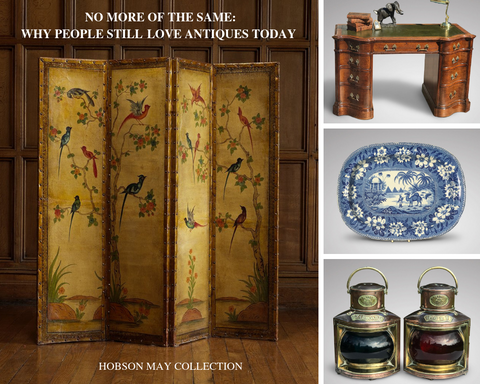No More of the Same: Why People Still Love Antiques today
Posted on 06 November 2018

It’s true that industrialised production has made lives more convenient and things cheaper to buy with technology disrupting the way we communicate, but are today’s consumers only satisfied with mass production?
Is there a hankering for something more personalised, different and authentic outside of an increasingly homogenised digital world?
Now, of course at HMC we’re biased. Yes, it’s true we’re naturally charmed by unique, beautiful items from a time before.
However, we don’t feel we’re alone with our penchant for something a little bit different..
Something different in a sea of sameness
While today’s customers have embraced and benefited from mass-produced goods like smartphones and wearables - they increasingly crave things that set them apart.
Online businesses, such as Etsy are thriving and Amazon’s recent launch of the growing competitor marketplace, Amazon Handmade is a sign of the growing demand for unique products.
According to Forbes, the online crafts business reported a 30% increase in Q2 revenue this year. The total value of handmade goods, vintage items and crafts supplies sold on its platform rose 20%, to $902 million, as active buyers jumped 17% to about 36 million. The value of goods bought has soared to an annual total of $3.3 billion, from just $1 million in its first year.
These figures are reflective of a growing demand for bespoke, personalised and non-mass produced items.

The Personalised Touch
Customers are also demanding the personalised touch. Bespoke garments are rapidly becoming the most coveted pieces with stores such as Selfridges creating dedicated bespoke ateliers in both womenswear and in beauty.
According to Deloitte research, one in three consumers surveyed were interested in personalised products, with 71% of those prepared to pay a premium for embellishments, and design.
Antiques for today’s consumer
Within this context, it’s no surprise that there is a growing demand for antiques and in particular an increased appreciation of juxtaposing old with new in interior design and homes.

The Fusion of Old and New
It’s all about achieving the careful balance in a room scheme and to avoid overclutter and overwhelm.
Mixing different styles within the same scheme works if there is a balance.
A room that cleverly achieves a fusion of old and new is cohesive and calm; there’s no sole statement piece - the styles should work well to complement one another. Each item should be of the best quality and beautiful in its own right. Context is everything and using pieces that contrast in period is better than a single bold piece that only works in isolation. The scale of each piece within the space is important, as the proportions are crucial, particularly when creating an eclectic scheme.
Oversized designs generally work very well, for example when combining contemporary seating with classical mirrors.

A fabulous Regency giltwood mirror c. 1815, surmounted by a spectacular winged dragon standing, flanked by beautifully carved hippocampi or mythical seahorses. The mercury glass plate is surrounded by an ebony reeded slip. The base of the carved and gilded frame is decorated with carved acanthus leaves.
Another way to fuse old and new is through creativity with furniture. Through upcycling vintage pieces using contemporary fabrics and colours you can achieve a unique piece of furniture that bridges the gap between periods or styles.

This 19th Century button armchair, dated c. 1860 is newly upholstered in a beautiful grey, cloud velvet and extremely inviting. The luxurious proportions and decorative mahogany turned feet with original brass castors indicate the quality of this beautiful piece.
Mixing fabrics with different textures can provide a welcome contrast. Texture and layering, for example with throws and cushions, can create an inviting ambiance and provide a foil to wood or leather furniture.
This exquisite cushion has a 19th century antique tapestry worked in pastel shades with highlights of soft blue and rose complemented with oyster coloured silk surround.
It’s clear that antiques certainly don’t belong in the past and their history and individuality make them attractive to today’s consumer as we seek respite from a sea of sameness.
Watch out for our next blog coming soon!
Feel free to browse our collection of completely unique, one-of-a kind antiques for your little bit of different.
Best Wishes from the team at HMC.




0 comments